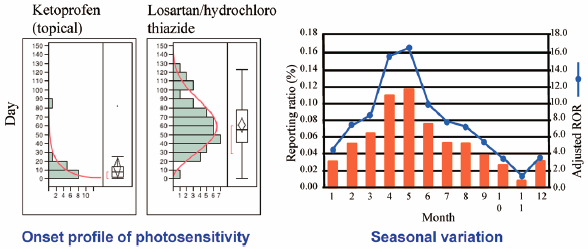- 著者
- Satoshi Nakao Haruna Hatahira Sayaka Sasaoka Shiori Hasegawa Yumi Motooka Natsumi Ueda Junko Abe Akiho Fukuda Misa Naganuma Hiroyuki Kanoh Mariko Seishima Motoyuki Ishiguro Yasutomi Kinosada Mitsuhiro Nakamura
- 出版者
- The Pharmaceutical Society of Japan
- 雑誌
- Biological and Pharmaceutical Bulletin (ISSN:09186158)
- 巻号頁・発行日
- vol.40, no.12, pp.2158-2165, 2017-12-01 (Released:2017-12-01)
- 参考文献数
- 50
- 被引用文献数
- 10 27
Drug-induced photosensitivity (DIP) refers to the development of cutaneous disorders caused by the combined effects of different medications and light. The aim of this study was to obtain new information on drug risk comparisons and on DIP onset profiles, including seasonal variations, for clinically used prescription drugs. We analyzed reports of DIP recorded in the Japanese Adverse Drug Event Report (JADER) database using a reporting odds ratio (ROR). We also used Weibull proportional-hazards models for each drug to examine the patterns of DIP. The JADER database contains 430587 reports recorded from April 2004 to November 2016. The ROR values (95% confidence interval [CI]) of losartan/hydrochlorothiazide (HCTZ), valsartan/HCTZ, and ketoprofen were 214.5 (162.1–283.9), 104.7 (66.3–165.5), and 117.9 (76.6–181.5), respectively. For time-to-onset analysis, the median durations (interquartile range) for DIP caused by losartan/HCTZ, valsartan/HCTZ, and ketoprofen were 56 (41–78), 49 (38–88), and 8 (2–14) days, respectively. The lower limit of the 95% CI for the Weibull shape parameter β value for losartan/HCTZ was greater than 1. More than half of the reports of DIP onset following the administration of ketoprofen were recorded within 10 d of treatment initiation. The seasonal variation of photosensitivity reactions was shown to follow an annual sinusoidal pattern with a peak in April and May. Based on the results, losartan/HCTZ, valsartan/HCTZ, and ketoprofen should be used carefully in clinical practice to avoid DIP.
